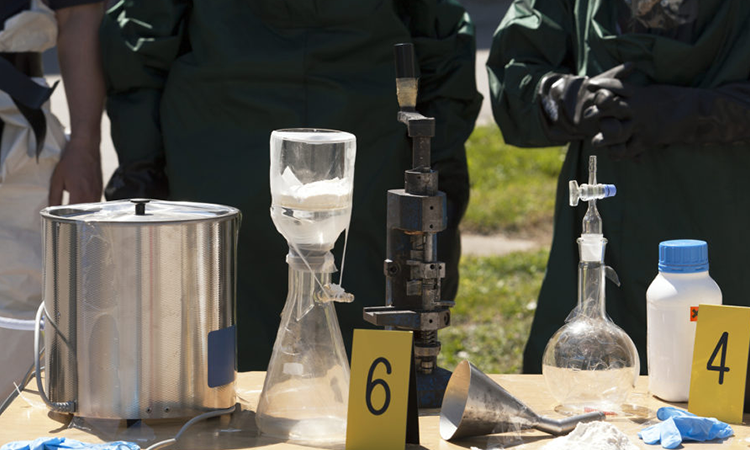
The length of time crystal meth stays in your system can vary depending on several factors, including the following:
- Overall health
- Body size of the user
- Hydration levels
- Liver and kidney function
- Frequency of meth use
- Route of drug administration
- Other substances present in the system
What Is Meth?
Crystal meth is the crystalline form of the illicit, synthetic drug methamphetamine. Meth is generally either smoked, snorted, or injected, although crystal meth, in particular, is almost always smoked. Meth, also known as crank, speed, or ice, is a central nervous system stimulant that works by elevating concentrations of the neurotransmitter dopamine in the brain. Dopamine is responsible for feelings of confidence, well-being, and euphoria. Moreover, meth also boosts energy levels, reduces appetite, and enhances libido.
A meth high usually lasts between six to eight hours but can endure for up to 24 hours. Meth abuse causes a variety of adverse effects on the health of the user, such as cardiac and neural damage, psychological instability, and memory loss.
Meth sends the body into overdrive, severely taxing the system’s resources. Repeated meth consumption impairs the body’s ability to create and maintain normal levels of dopamine, and becomes dependent on meth to function normally. Because of the withdrawal effects that occur when someone tries to cut back or stop, meth is terribly addictive, though meth addiction can occur after only a single use.
The Half-Life of Meth
Once taken, the body works to rid itself of meth. A substance’s half-life is the amount of time required for the body to reduce the amount of that substance in the system by half. Meth’s half-life is between 10 and 12 hours, which is relatively long, compared to some other drugs. For this reason, meth is detectable using urine drug tests for around three days after the most recent use.
Meth’s half-life varies depending on the method used to ingest it. When injected, meth’s half-life is usually more than 11 hours, whereas smoking crystal meth or snorted powder meth typically give it a shorter half-life. Furthermore, the longer one has been using meth, the longer it usually takes to clear it out, and having other substances present in the system alongside meth only exacerbates this.
Research indicates that the amount of meth consumed at any one time has only a nominal effect on its half-life. Nonetheless, high doses can increase the rate at which meth accumulates in the body, and accumulation decreases the rate at which meth is eliminated.
Moreover, because the liver and kidneys of a young person generally metabolize meth better, the older one is, the longer it takes to detox. And, the overall health of an individual tends to expedite meth elimination. For example, an athlete can usually expect to be clean of meth before a non-athlete.
Testing for Meth
Meth is detectable by saliva tests as recently as five or ten minutes after consumption, and for around three days. In comparison, a hair follicle analysis requires roughly a week’s time after the most recent dose to detect meth but has a considerably larger time frame of up to 90 days. And, urine tests generate positive results as early as two to five hours after the last use, and for between three to five days.
Drug testing for meth is typically administered to athletes since meth is one of many performance-enhancing drugs banned by the World Anti-Doping Agency. Furthermore, it is a common practice for employers to test current or potential employees, and many rehab programs regularly test for meth as well. Meth testing will generate positive results for a long time after the most recent use if preceded by a long period of consistent meth use.
Signs and Symptoms of a Meth Overdose
Individuals risk overdose when using meth, typically by overestimating their body’s ability to handle exorbitantly large doses, or through long-term repetitive meth use that leads to its accumulation in the system. When an overdose is rapidly precipitated, it is considered acute, and when it gradually develops, it is deemed to be chronic. Although both pathways to overdose are altogether devastating and share some of the same effects, they do differ in many respects.
Signs and symptoms of acute meth overdose include the following:
- Altered mental status
- Agitation
- Hypervigilance
- Nausea and vomiting
- Elevated body temperature and blood pressure
- Difficulty breathing
- Chest or stomach pains
- Seizures
- Cardiac arrhythmia, heart attack
- Kidney failure
- Stroke
Signs and symptoms of chronic meth overdose include the following:
- Sleep disturbances and deprivation
- Extreme mood changes
- Depression or severe anxiety
- Erratic and violent behavior
- Meth psychosis, paranoia
- Excessive weight loss and malnutrition resulting in organ failure
- Recurrent bacterial infections
- Severe tooth decay, “meth mouth”
- Compromised kidney, liver, and lung function
- Hypertension
Treatment for Meth Addiction
Meth addiction is a devasting disease that can adversely affect the lives of the addicted as well as those close to him or her. Treatment should be based on a comprehensive approach that is customized to the individual and includes therapies, counseling, and group support.
Our center can help you or your loved one regain their life, free from addiction, and enjoy long-lasting happiness and wellness. Please contact us as soon as possible!